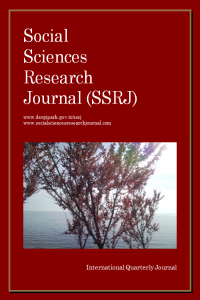Gelişmişlik Göstergelerine Göre İnsani Kalkınmaya Dayalı Gruplamanın Temsil Gücü: Bir Uygulama
insani gelişme, istatistik, anova, kruskal-wallis, kalkınma ekonomisi
REPRESENTATIVE POWER OF HUMAN DEVELOPMENT BASED GROUPING ACCORDING TO DEVELOPMENT INDICATORS: AN APPLICATION
human development, statistics, anova, kruskal-wallis, development economics,
___
- Alpar, R. (2016). Uygulamalı İstatistik ve Geçerlik-Güvenirlik, Ankara: Detay Yayıncılık.
- Aguna, C., & Kovacevic, M. (2011). Uncertainty and sensitivity analysis of the human development index. Human Development Research Paper, 11, UNDP publishing, New York and Ceneva.
- Çiftçi, M. (2017). Beşeri kalkınma endeksinde kuramsal ve istatistiksel yetersizlikler: Sosyal politika perspektifiyle alternatif endeks tasarımı. Avrasya Bilimler Akademisi İşletme ve İktisat Dergisi, 11, 1-32.
- Foster, J. E., Lopez-Calva, L. F., & Szekely, M. (2005). Measuring the distribution of human development: methodology and an application to Mexico. Journal of Human Development, 6(1), 5-25.
- Grimm, M., Harttgen, K., Klasen, S., & Misselhorn, M. (2008). A human development index by income groups. World Development, 36(12), 2527-2546.
- Kovacevic, M. (2010). Measurement of inequality in Human Development–A review. Measurement, Human Development Research Paper, 35.
- Land, K. C. (2015). The human development index: objective approaches (2). In Global Handbook of Quality of Life (pp. 133-157). Springer, Dordrecht.
- Liu, S. Y., Wu, P. C., & Huang, T. Y. (2018). Nonlinear Causality between Education and Health: the Role of Human Development Index. Applied Research in Quality of Life, 13(3), 761-777.
- Nugrahadi, E. W., & Rinaldi, M. (2018, January). Analysis of Human Development Index: Concept and Factors that Influence North Sumatera Province. In 1st Economics and Business International Conference 2017 (EBIC 2017). Atlantis Press.
- Pinar, M., Stengos, T., & Topaloglou, N. (2017). Testing for the implicit weights of the dimensions of the Human Development Index using stochastic dominance. Economics Letters, 161, 38-42.
- UNDP (2018). Human Development Report 2018, New York.
- Wolff, H., Chong, H., & Auffhammer, M. (2011). Classification, detection and consequences of data error: evidence from the human development index. The Economic Journal, 121(553), 843-870.
- Yayın Aralığı: Yılda 4 Sayı
- Yayıncı: Denta Florya ADSM Limited Company
Ücret Denklemlerinin Tahmininde Pseudo Panel Veri Yaklaşımı
Trakya Bölgesinde İkinci Basamak Kamu Sağlık Hizmetlerinde Yaşlı Refahı
Gelişmişlik Göstergelerine Göre İnsani Kalkınmaya Dayalı Gruplamanın Temsil Gücü: Bir Uygulama
Ayşe Nur ÇİFTÇİ, Muhammet ATALAY
2008 Krizi Sonrası Avrupa Birliği’nde Toplu Pazarlık: Fransa ve Romanya
Yasemin KOLDERE AKIN, Cenk TURAN
Hatice KÜÇÜKKAYA, Sinem DÜNDAR
İlkokul Öğrencilerinin Bilim ve Bilim İnsanına İlişkin Algıları
Bilgi İletişim Teknolojileri (ICT) Yayiliminin Faiz Oranlarina Etkisi: Panel Analiz
Seyfettin ÜNAL, Cüneyt KOYUNCU
Brics Ülkeleri ile Türkiye’de Tasarruf Davranışlarını Belirleyen Faktörler
